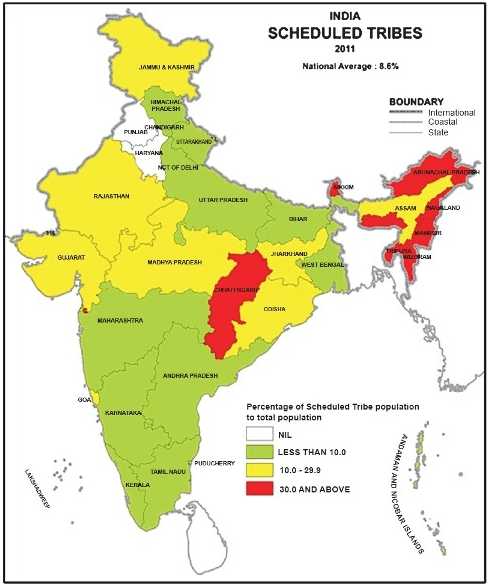Tribal Integration in India | Post Independence History for UPSC Mains PDF Download
Tribal Integration
During colonial times money lenders, traders & petty officials invaded the tribal areas and disrupted the tribal’s traditional way of life. To conserve forests and to facilitate their commercial exploitation, the colonial authorities brought large tracts of forest lands under forest laws which forbade shifting cultivation & put severe restrictions on the tribals use of forest and their access to forest products.
- Loss of land, indebtness
- Exploitation by middlemen
- Denial of access to forests & forest products
- Oppression & extortion by policemen, forest officials and other government officials
All this led to a series of tribal uprisings in the 19th & 20th centuries, e.g. Santhal & Munda rebellion
Tribal Integration Post Independence
Tribal integration was an extremely difficult task due to:
- Diverse dwelling conditions
- Different cultures & tradition
- Varied languages
- Spread all over India
- Resided mostly in hills & forest areas in colonial India
- Lived in isolation
- Different habits and ways of life with their non-tribal neighbours

Their greatest concentration was found at Madhya Pradesh, Bihar, Orissa, NE India, West Bengal, Maharashtra, Gujarat & Rajasthan. Except North-East, they constitute minorities in their home states.
India Tribal Policy
Nehru stood for economic & social development of tribal people in multifarious ways, especially in the fields of modern medical facilities communications, agriculture and education. There were certain broad guidelines laid down by Nehru, with the help of V Elwin, which was called as “Tribal Panchsheel”. They are:
- People should develop along the line of their own genius – avoid imposing anything on them
- Try to encourage in every way their own traditional arts and culture
- Tribals rights to land and forest should be respected
- Technical experts needed for development but avoid introducing too many outsiders into tribal territory.
- Judge results not by statistics or amount of money spent, but by the quality of human character involved.
- Should not over administer these areas or overwhelm them with a multiplicity of schemes
In spite of the constitutional safeguards and the efforts of central & state governments, the tribals progress and welfare has been very slow. Except North East, the tribals continue to be poor, indebted, landless and often unemployed. Problem lies in weak execution of even well intentioned measures.
Reasons for dismal performance of Tribal Policy
- Quite often the funds allocated for tribal welfare are not spent or are spent without corresponding results and sometimes funds are even misappropriated.
- Administrative personnel are either ill trained or prejudiced against tribals.
- Denial of justice, often because of their unfamiliarity with the laws & the legal system.
- Violation of strict land transfer laws to tribals, leading to alienation of land & eviction of tribals.
- Rapid extension of mines & industries has worsened their conditions in many areas.
- The progress of education among the tribal people has been disappointingly slow.
- Exploitations from the forest officials and unsympathetic attitude of officials.
Positive Development happened due to state’s Initiative
- Legislation to protect tribal rights & interests
- Activities of the tribal welfare departments
- Panchayati Raj, spread of literacy and education
- Reservations in government services and in Parliament + state assemblies
- Reservation in higher education institutions
- Tribal art & craft mela for example Adiship
- Efforts by TRIFED for example marketing of MFP (minor forest produce)
- Various Health policies exclusive for tribals
|
28 videos|44 docs|21 tests
|
FAQs on Tribal Integration in India - Post Independence History for UPSC Mains
| 1. What is tribal integration in India? |  |
| 2. What are the challenges faced in tribal integration in India? |  |
| 3. How does the Indian government promote tribal integration? |  |
| 4. What are the benefits of tribal integration in India? |  |
| 5. How can individuals contribute to tribal integration in India? |  |

















